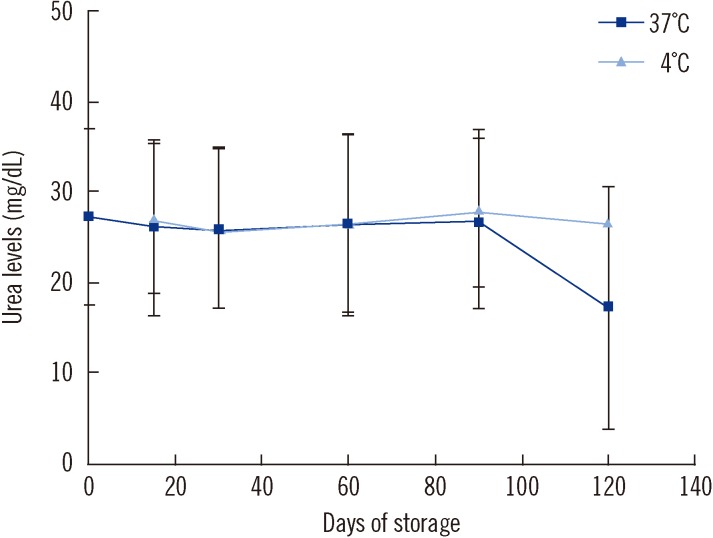Ann Lab Med.
2013 May;33(3):190-192. 10.3343/alm.2013.33.3.190.
Analysis of the Stability of Urea in Dried Blood Spots Collected and Stored on Filter Paper
- Affiliations
-
- 1National Drug Dependence Treatment Centre, Department of Psychiatry, All Indian Institute of Medical Sciences (AIIMS), New Delhi, India. rizwanaquraishi@gmail.com
- 2Department of Cardiac Biochemistry, Cardio-Neuro Centre, AIIMS, New Delhi, India.
- 3Department of Laboratory Medicine, AIIMS, New Delhi, India.
- 4North-East Region, Biotechnology Programme Management Cell, Department of Biotechnology, New Delhi, India.
- KMID: 1781324
- DOI: http://doi.org/10.3343/alm.2013.33.3.190
Abstract
- The ability to use dry blood spots (DBSs) on filter paper for the analysis of urea levels could be an important diagnostic tool for areas that have limited access to laboratory facilities. We developed a method for the extraction and quantification of urea from DBSs that were stored on 3M Whatman filter paper and investigated the effect of long-term storage on the level of urea in DBSs. DBSs of 4.5 mm in diameter were used for our assay, and we determined the urea levels in blood using a commercially available enzymatic kit (UV GLDH-method; Randox laboratories Ltd., UK). The DBSs on filter discs were stored at 4degrees C or at 37degrees C for 120 days. The mean intra- and inter-assay coefficient of variance for our method of urea extraction from dried blood was 4.2% and 6.3%, respectively. We collected 75 fresh blood samples and compared the urea content of each fresh sample with the urea content of DBSs taken from corresponding fresh blood samples. Regression analysis reported a regression coefficient (r) value of 0.97 and a recovery of urea from dried spots was 102.2%. Urea concentrations in DBSs were stable for up to 120 and 90 days when stored at 4degrees C and 37degrees C, respectively. Our results show that urea can be stored and quantitatively recovered from small volumes of blood that was collected on filter paper.
Keyword
MeSH Terms
Figure
Cited by 1 articles
-
Advances in the use of dried blood spots on filter paper to monitor kidney disease
Carla Nicola, Vandréa de Souza
Child Kidney Dis. 2024;28(1):16-26. doi: 10.3339/ckd.23.023.
Reference
-
1. Skovby F, Micic S, Jepsen B, Larsen SO, Hansen B, Tegllund L, et al. Screening for familial hypercholesterolemia by measurement of apolipoproteins in capillary blood. Arch Dis Child. 1991; 66:844–847. PMID: 1863097.2. Howe CJ, Handelsman DJ. Use of filter paper for sample collection and transport in steroid pharmacology. Clin Chem. 1997; 43:1408–1415. PMID: 9267321.
Article3. Ramakrishnan L, Reddy KS, Jailkani BL. Measurement of cholesterol and triglycerides in dried serum and effect of storage. Clin Chem. 2001; 47:1113–1115. PMID: 11375303.4. Quraishi R, Lakshmy R, Prabhakaran D, Mukhopadhyay AK, Jailkhani BL. Use of filter paper stored dried blood for measurement of triglyceride. Lipids Health Dis. 2006; 5:20. PMID: 16839425.
Article5. Quraishi R, Lakshmy R, Prabhakaran D, Irshad M, Mukhopadhyay AK, Jailkhani BL. Effect of storage temperature on cholesterol measurement from dried blood. Indian J Med Res. 2007; 126:228–229. PMID: 18037719.6. Quraishi R, Lakshmy R, Mukhopadhyay AK, Jailkhani BL. Creatinine measurement and stability in dried serum. J Diabetes Sci Technol. 2012; 6:988–989. PMID: 22920830.
Article
- Full Text Links
- Actions
-
Cited
- CITED
-
- Close
- Share
- Similar articles
-
- Advances in the use of dried blood spots on filter paper to monitor kidney disease
- Rapid DNA Extraction from Dried Blood Spots on Filter Paper: Potential Applications in Biobanking
- Measurements of IgM anti-phenolic glycolipid-I antibodies using capillary blood samples
- The Detection of Plasmodium vivax DNA, and Antibody using Filter Paper Blood
- Organic Acid Analysis on Urine Sample Obtaine3d from Dried Filter Paper in Newborns: Development of Screening Method for Organic Aciduria in Neborns


